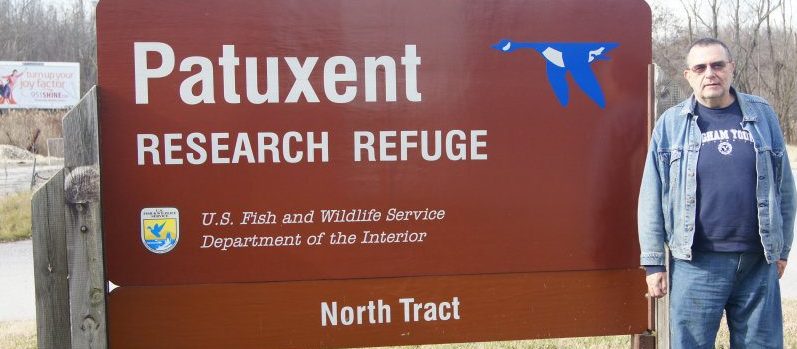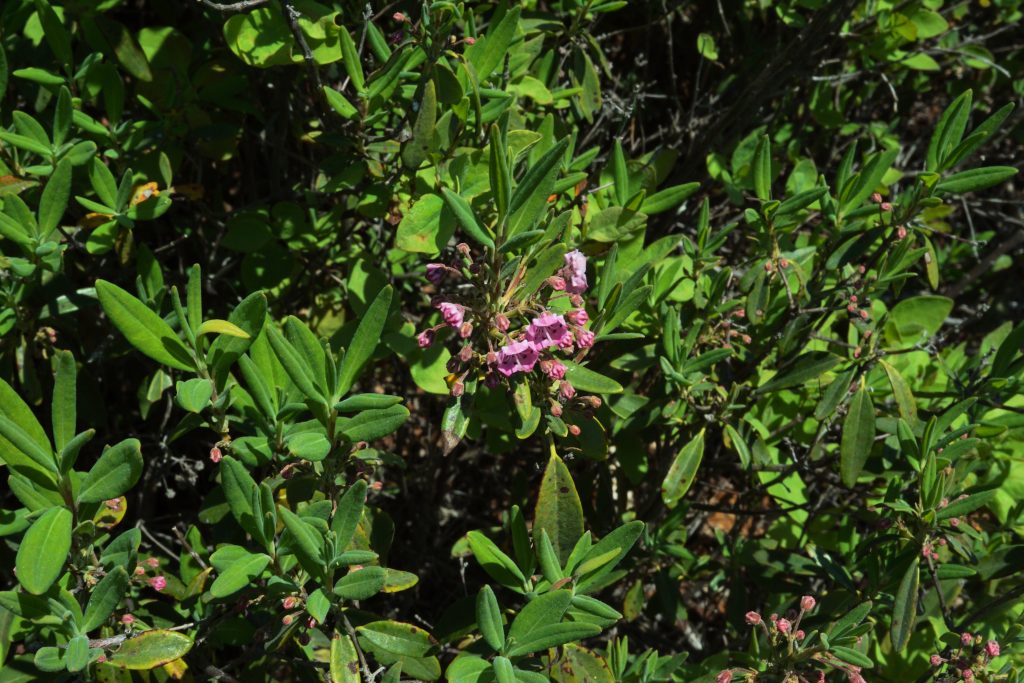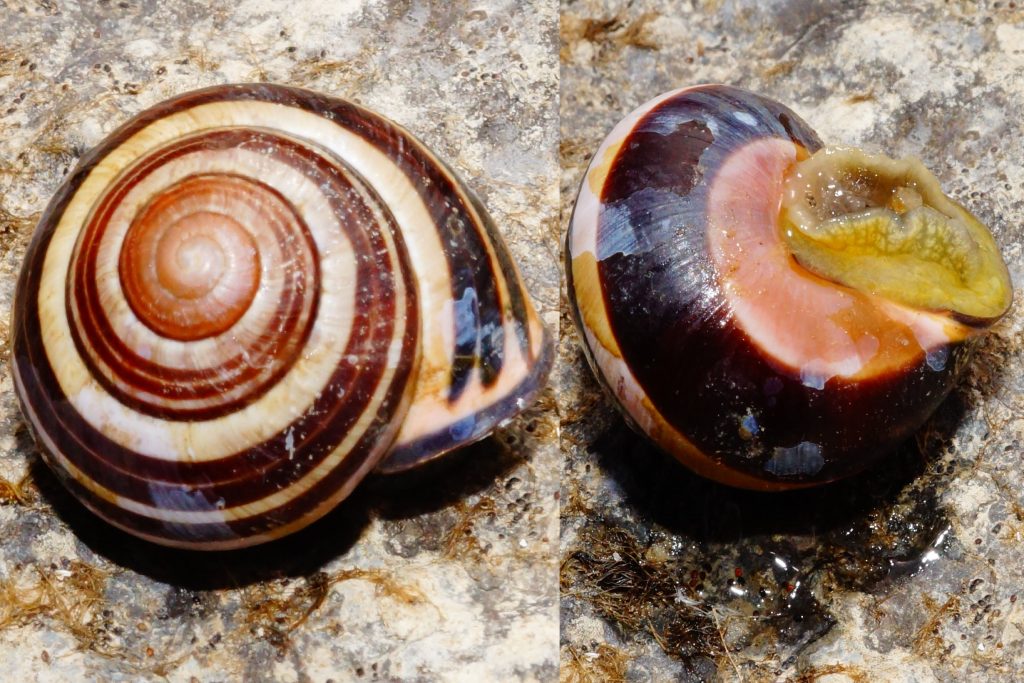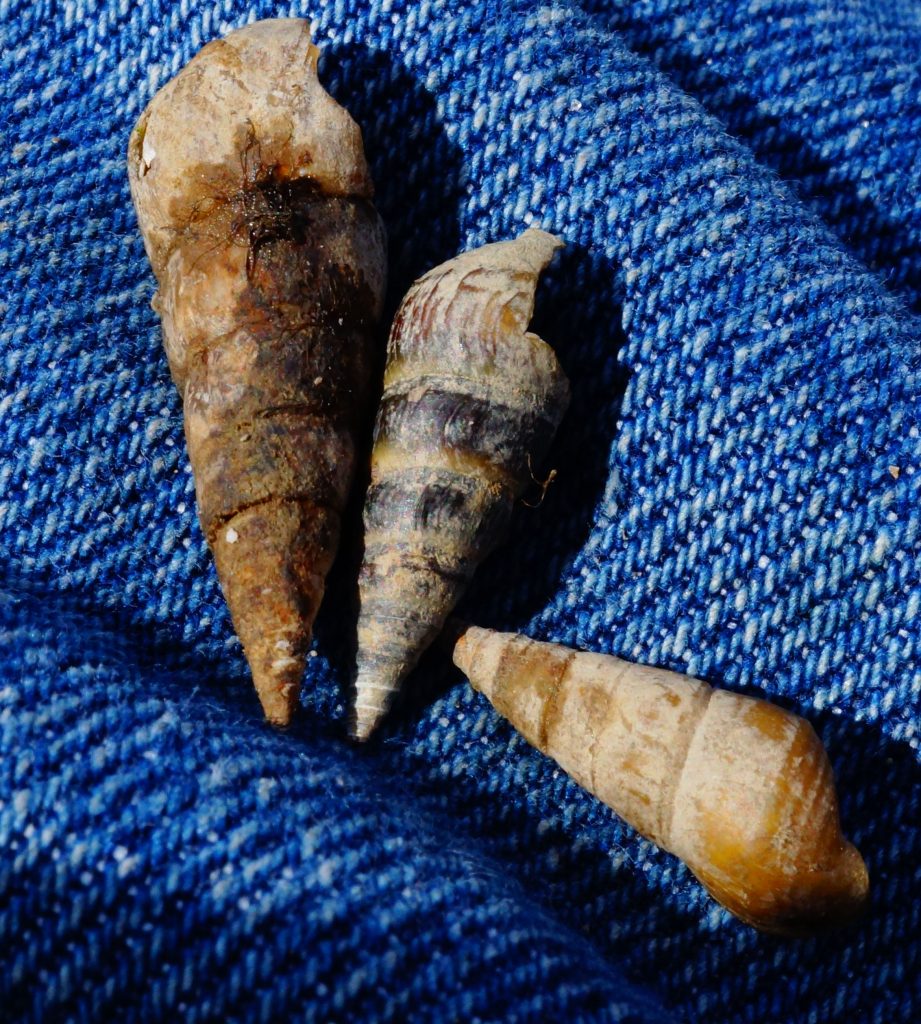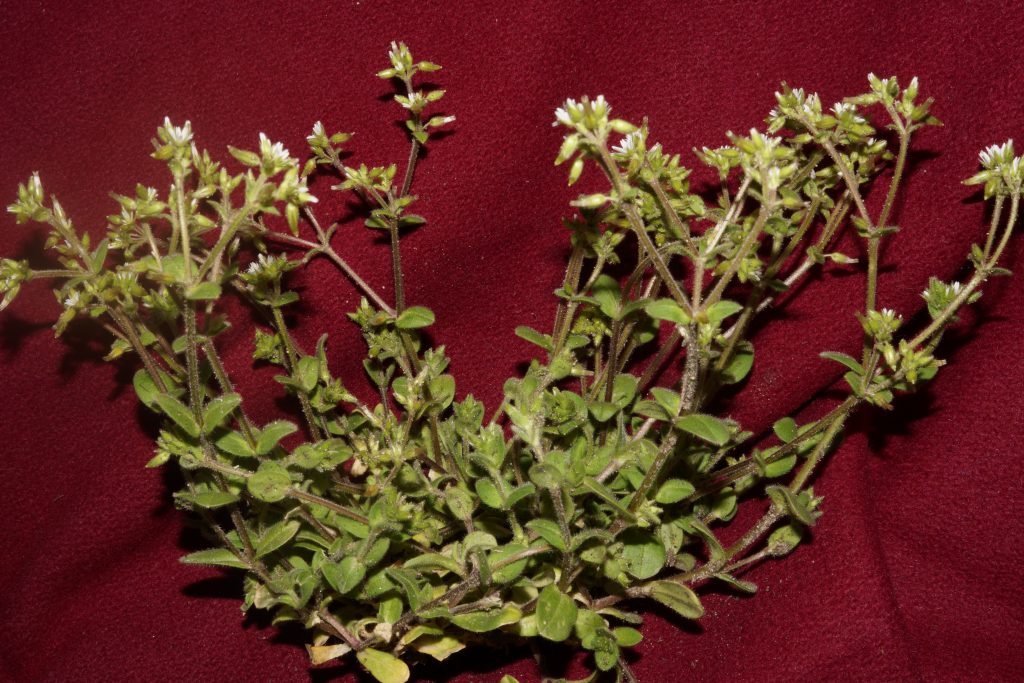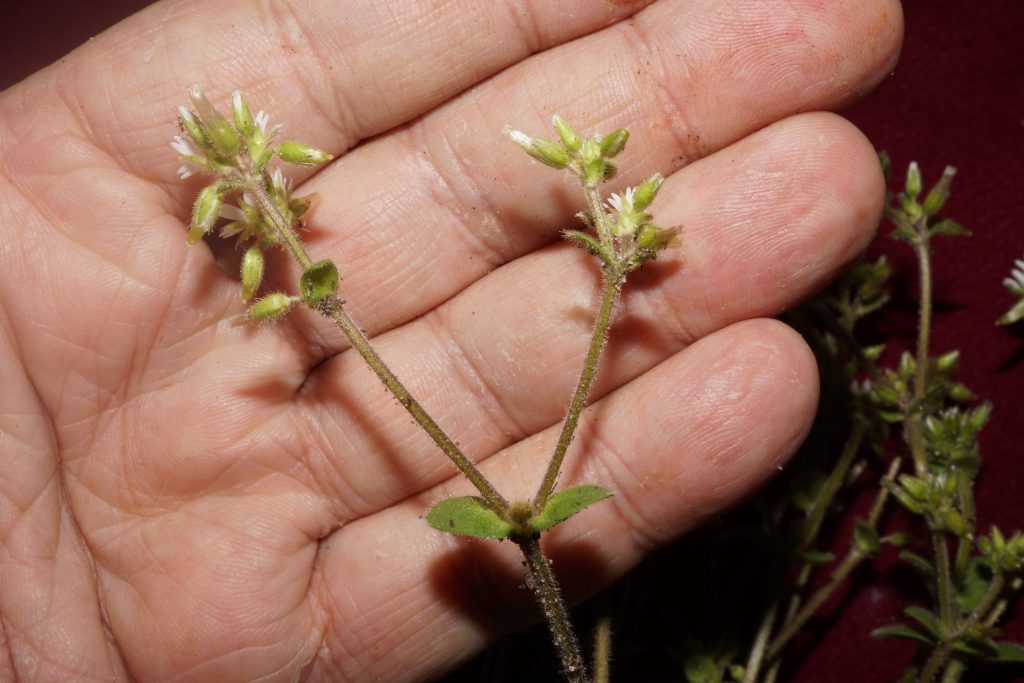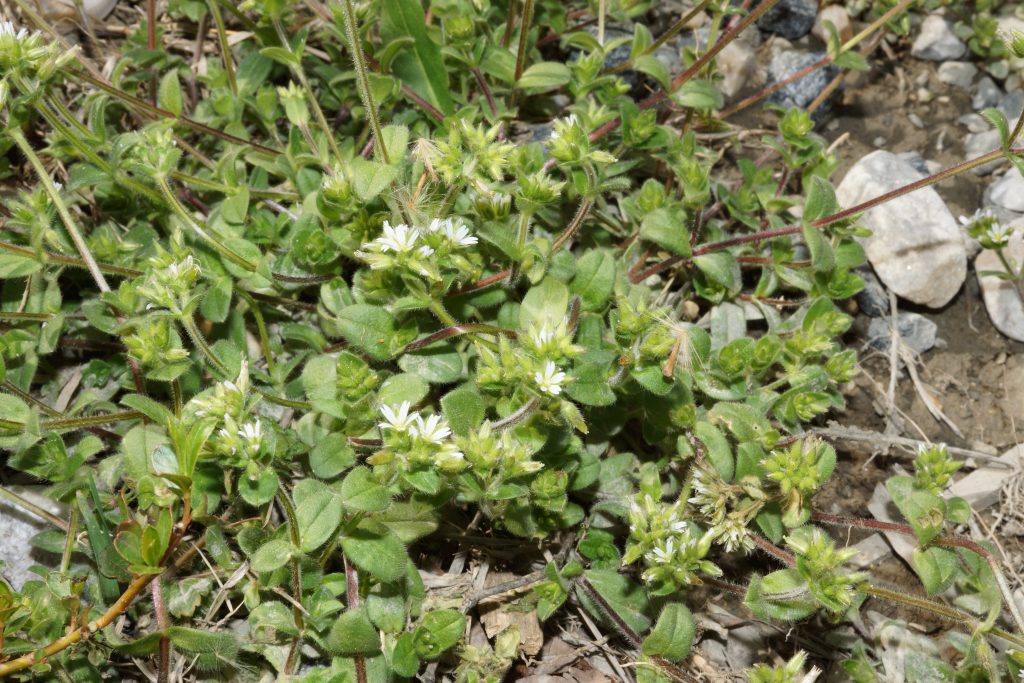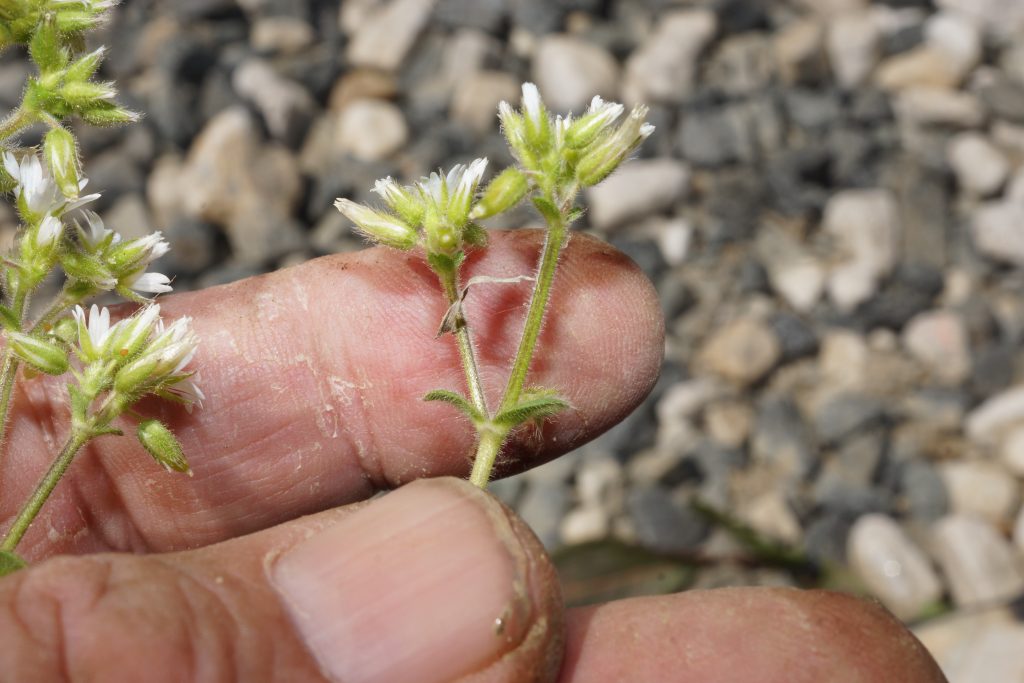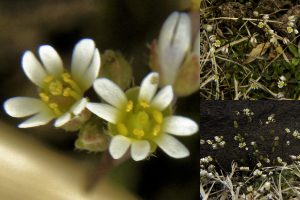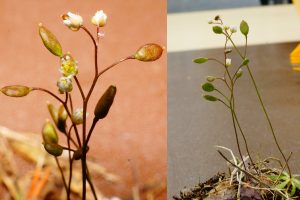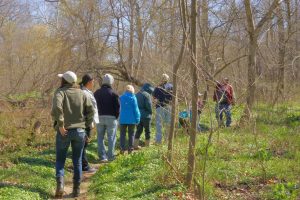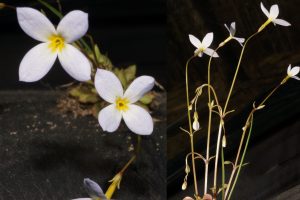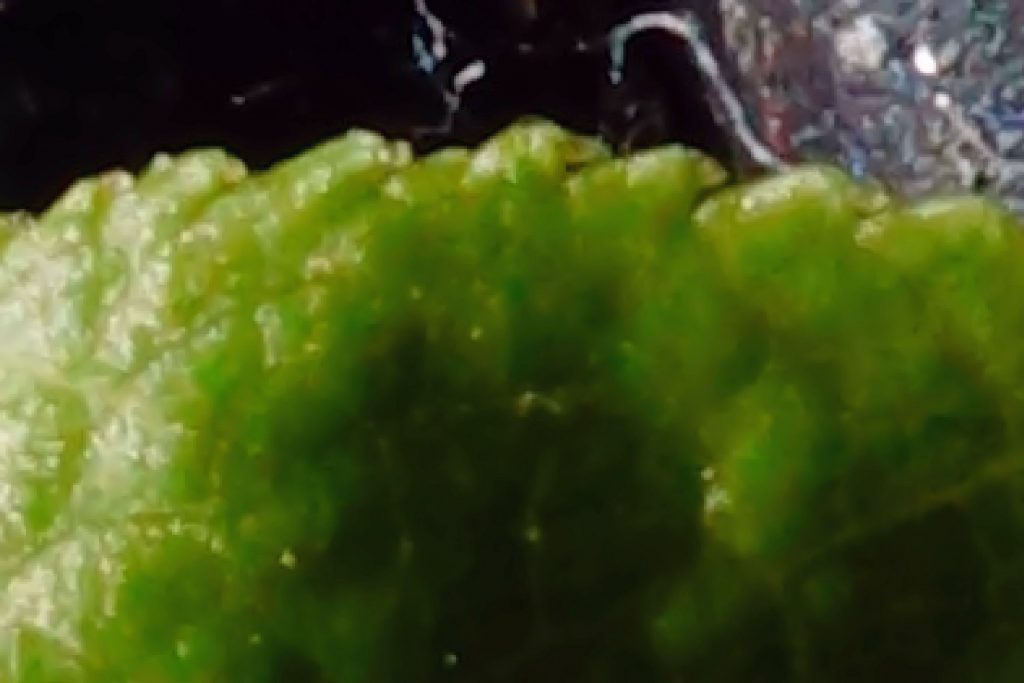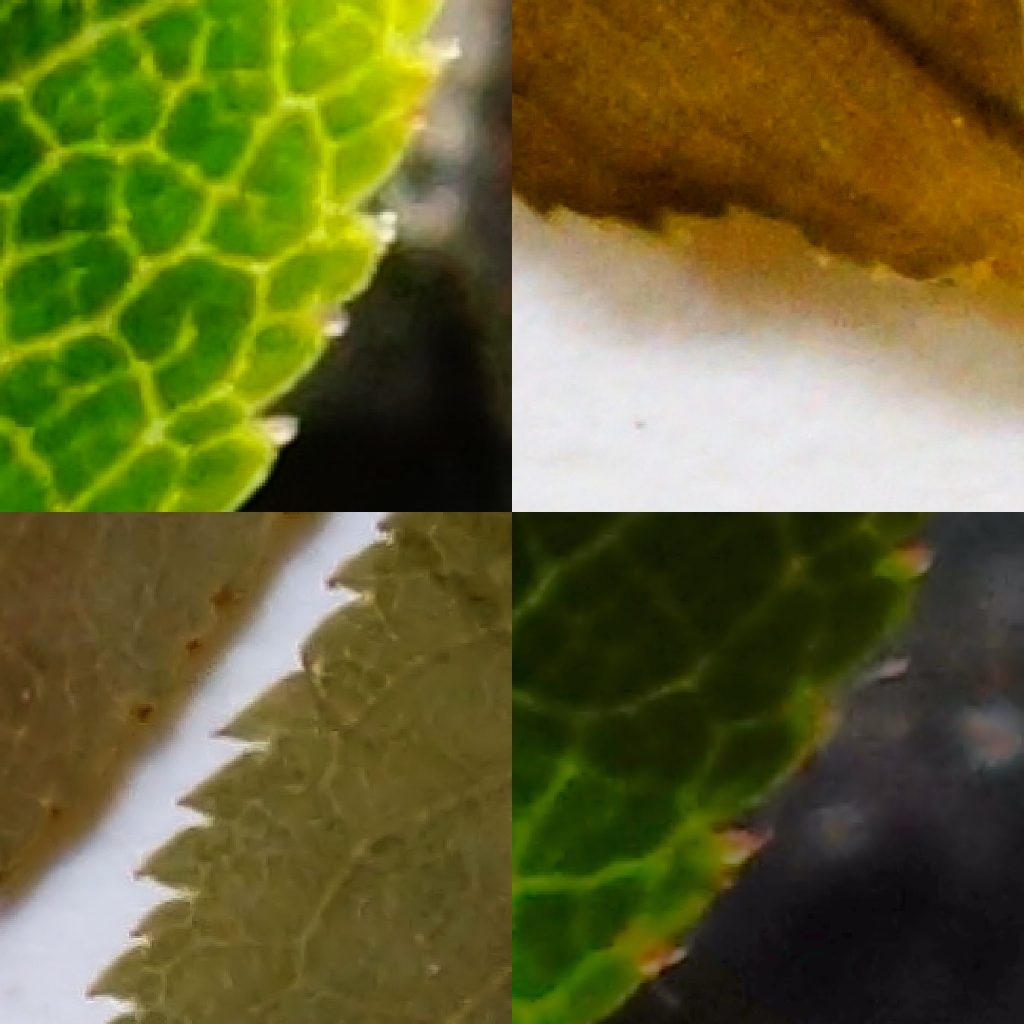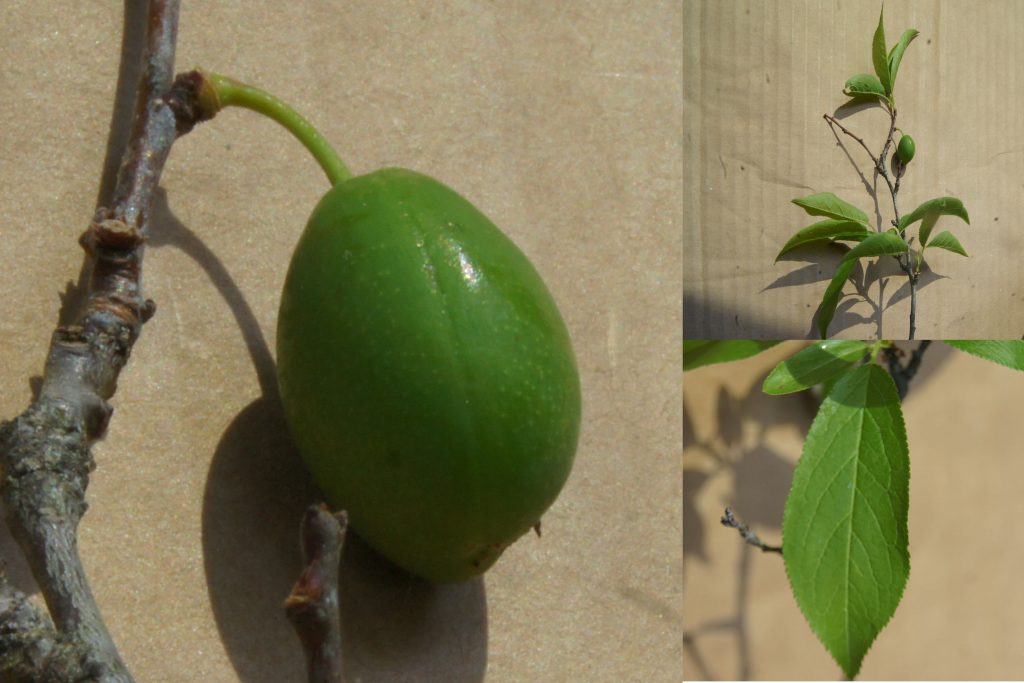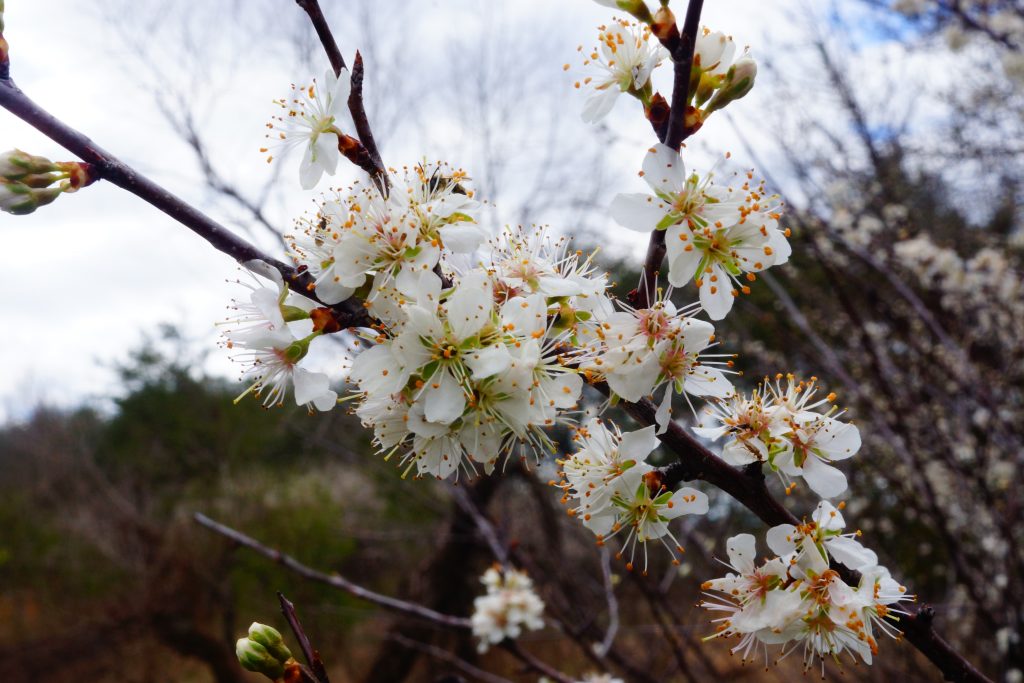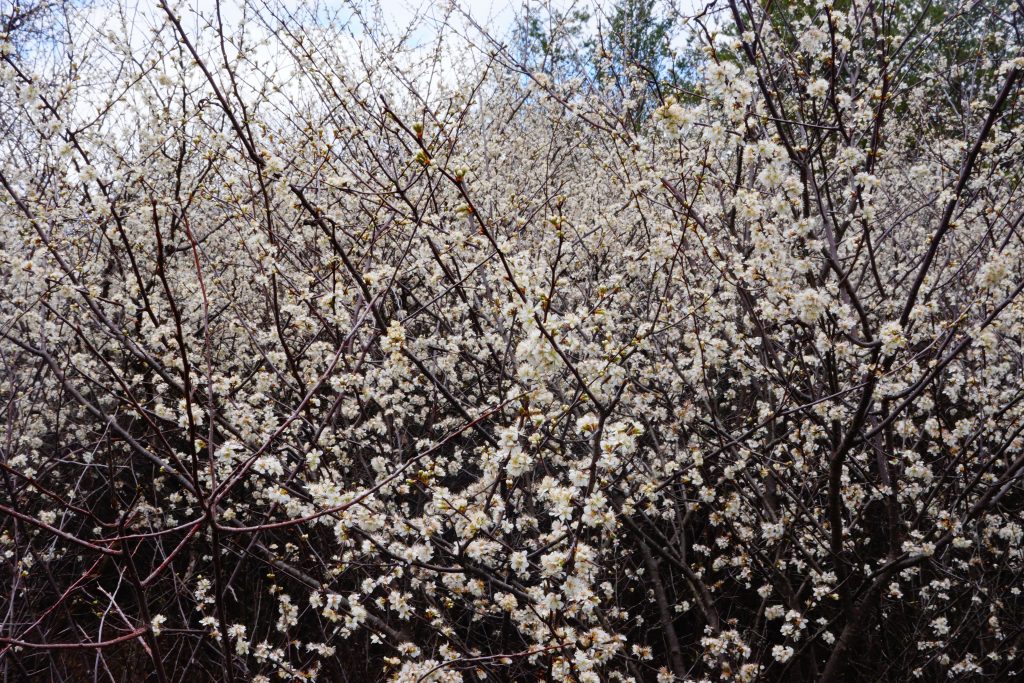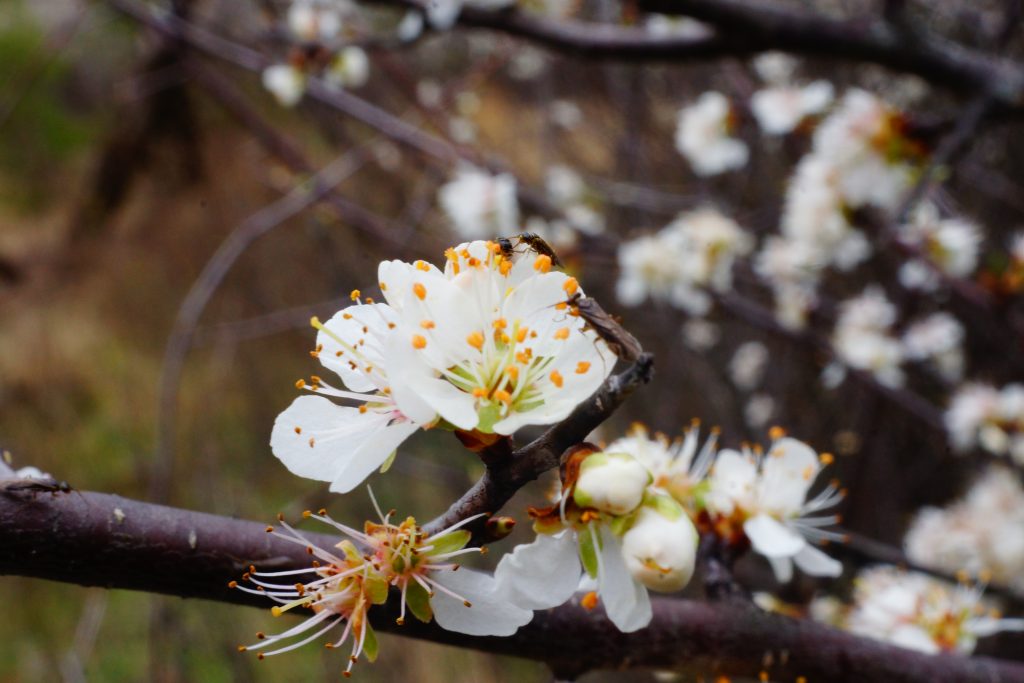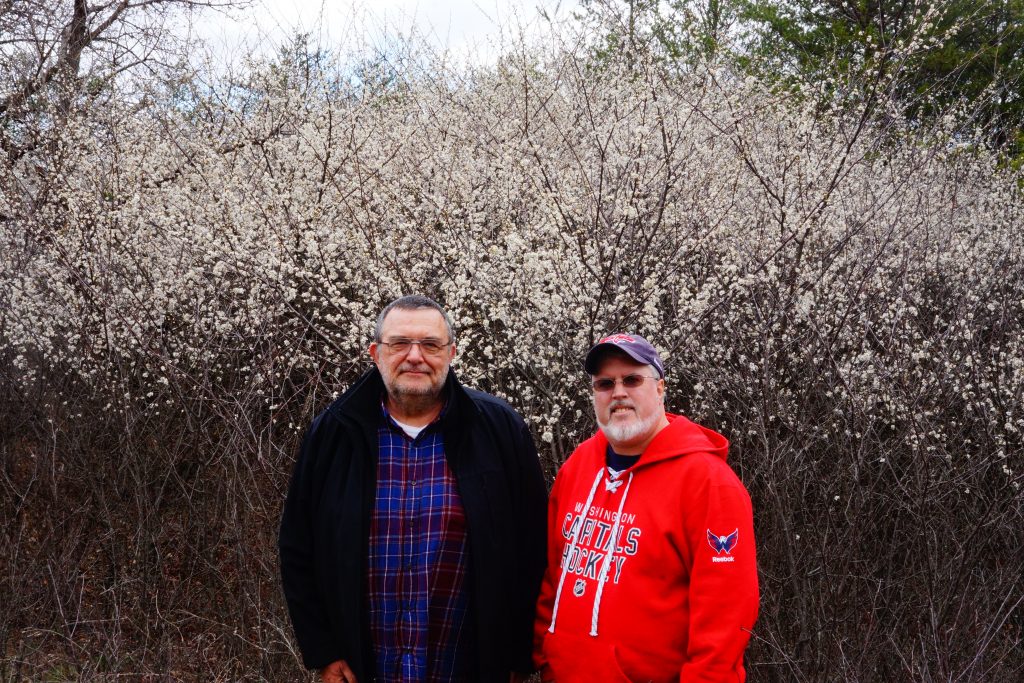 Kalmia angustifolia L. is a flowering shrub in the family Ericaceae, commonly known as sheep laurel. It is found in a small number of locations on the Refuge. Its natural range is from Quebec and Ontario on the north to Virginia on the south. There are several cultivated forms of this species including a red-flowered one that is popular in the nursery trade.
Kalmia angustifolia L. is a flowering shrub in the family Ericaceae, commonly known as sheep laurel. It is found in a small number of locations on the Refuge. Its natural range is from Quebec and Ontario on the north to Virginia on the south. There are several cultivated forms of this species including a red-flowered one that is popular in the nursery trade.
Category Archives: Journal
Kalmia angustifolia (Sheep Laurel)
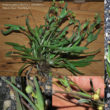
6 May 2017 – Newly Discovered Plant Species for Maryland
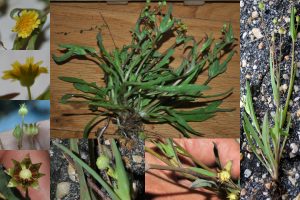
Today, I went out to the southern border of the Refuge to checkout the area around the old USDA Beltsville Landing Strip. There were several species of weeds hanging around. To my surprise, one of them ended up being a plant species that had not been documented for Maryland. It is called Krigia cespitosa (Raf.) K.L. Chambers or Weedy Dwarf Dandelion.
The Weedy Dwarf Dandelion is found throughout Southeast USA, including the neighboring states of Virginia and West Virginia, so its appearance in Maryland is not surprising. Since this plant was located at an airport historically associated with the USDA, it is very possible that it could have been introduced by an aircraft from another area. It would not be surprising if other as-of-yet-not-known species are at this site which were introduced by the same method. Another plant species new to Maryland, Lythrum hyssopifolia L. or Hyssop Loosestrife, was found near this location in June 2015.
There are three other species from the genus Krigia in Maryland – K. biflora, K. dandelion, and K. virginica. The lack of pappus in the flowering head is one of the traits which distinguishes K. cespitosa from the other three.
My original determination of this plant species has been verified by Rod Simmons and Wes Knapp.
25 April 2017 – Forget-me-not or not – Part 2 – SUCCESS!
 Last time we attempted to identify a Forget-Me-Not that was found growing in Oldtown Elkridge. (Click here to see the first part of the story.)
Last time we attempted to identify a Forget-Me-Not that was found growing in Oldtown Elkridge. (Click here to see the first part of the story.)
After looking at the key, we narrowed the possibilities down to three species – Myosotis arvensis, Myosotis discolor, and Myosotis stricta, the last three species on the key.
So today I went out to the station where we first found the plant. Of course, the flowering stems had elongated and there were more fruits. The fruiting pedicels were all shorter than the calyces. The plants were floriferous (with flowers) well below the middle of the flowering stems. I did not see any styles extending beyond the mericarps. After running this through the key in the first blog entry, we come up with Myosotis stricta Link ex Roem. & Schult. or Strict Forget-me-not.
CONCLUSION: sometimes you have to look at a plant at different stages to be sure of an identification.
SUCCESS!
16 April 2017 – Mollusks Galore
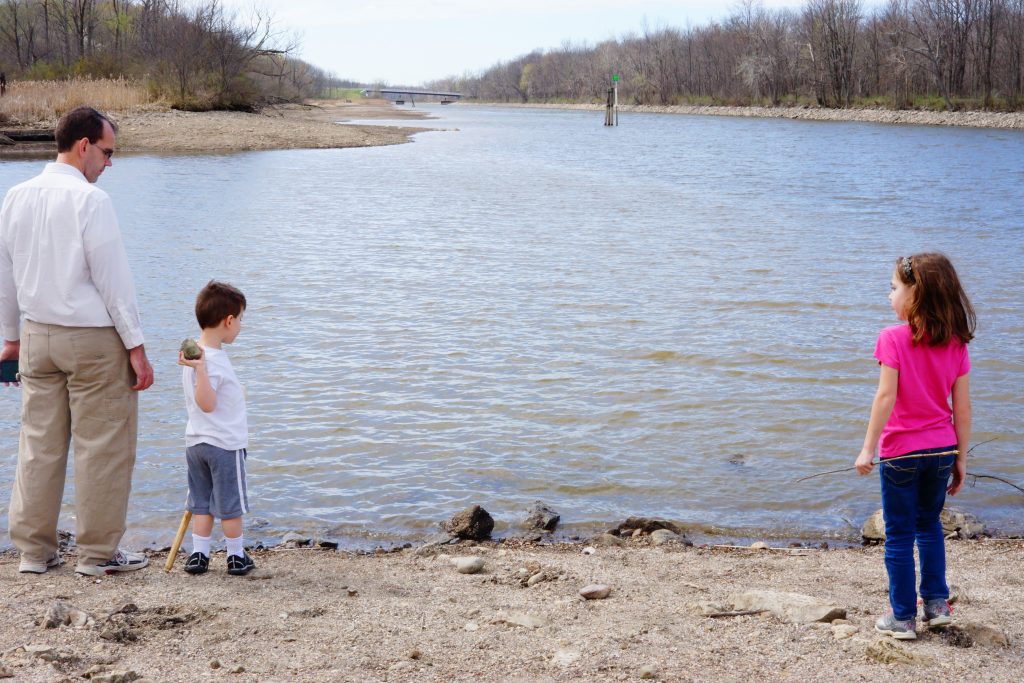
and the “New” Erie Canal on the right
This time we diverge from looking at plants. On our hike on the Butterfly Trail at Lock # 30, Erie Canal, Macedon, New York, we found at least four mollusks. In the first picture, you can see the “beach” where we found them. It was mostly made up of the remains of shells. We would like to know what are the exact species. If you know or can verify the exact species of these mollusks please let us know.
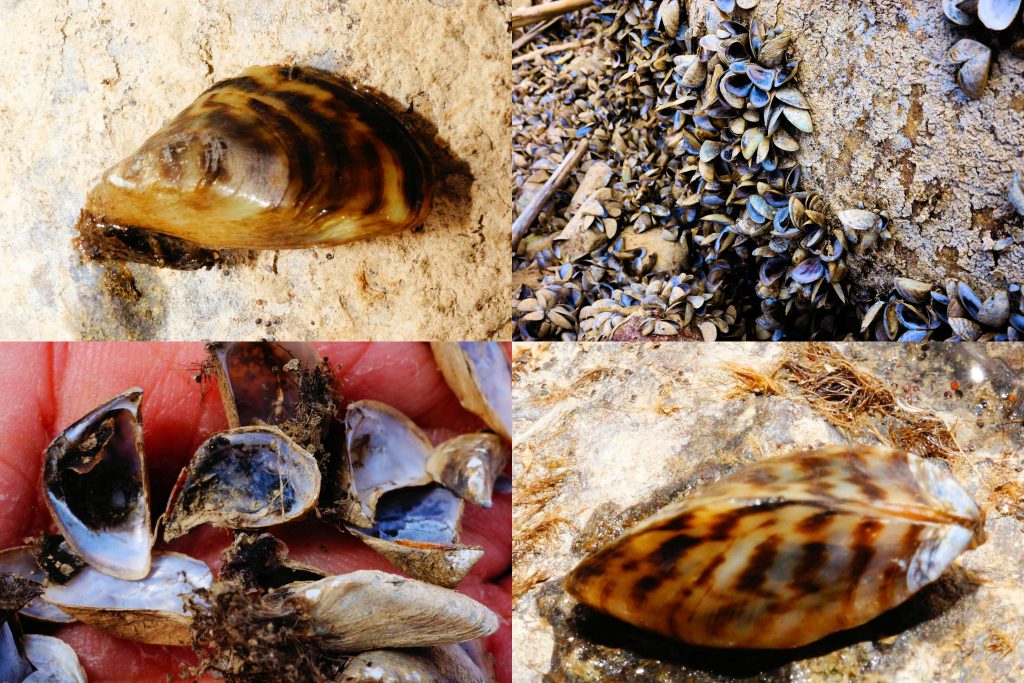
The first shells that we are looking at are Zebra Mussels (Dreissena polymorpha). They are an aggressive invasive species throughout a large portion of North America. They were first detected inNorth America in the Detroit-Windsor area in 1988. They are considered a serious pest.

This one is believed to be the bivalve mollusk called the Asian Clam (Corbicula fluminea).
I have no idea what this is. For this article I am calling it a Striped Snail. This little guy was alive when we found it.
I am calling this one a Cone Snail. They are similar to some snails that we used raised in aquariums when I was younger.
14 April 2017 – Poet’s Daffodil – Narcissus poeticus L. –
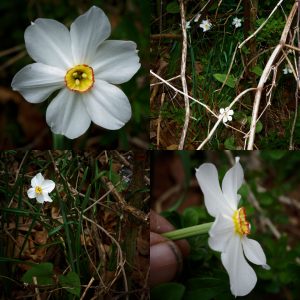
Today, I went on a botanical foray in Oldtown Elkridge concentrating on the area around the Thomas Viaduct and found several interesting exotics and even a few natives.
Pictured here is the Poet’s Daffodil – Narcissus poeticus L. It is native to south and central Europe and had become naturalized in other parts of the world including Maryland. At this location, there were several dozen plants.
Its short yellow reddish rimmed corona is a distinctive characteristic of this species.
The origin of the name Poet’s Narcissus is not clear, but one version states that the poet Virgil wrote about a Narcissus which matched the description of this plant in his fifth Eclogue. Theosphratus (371 – c. 287 BCE), in his botanical writings wrote about a spring blooming narcissus which subsequent writers consider to be this species.
REFERENCES:
Bourne, Stephen Eugene; W. L. Foster (1903). The Book of the Daffodil. J. Lane. p. 3.
Linnaeus, Carl von. 1753. Species Plantarum 1: 289, Narcissus poeticus
14 April 2017 – Oldtown Elkridge and Thomas Viaduct
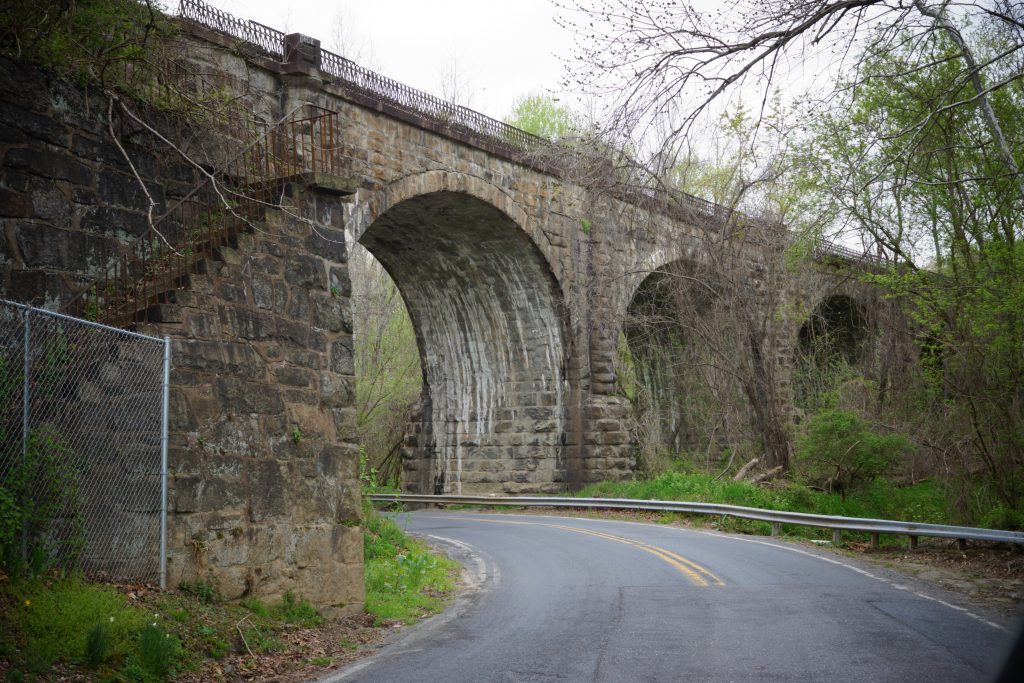
passing over Levering Avenue in Elkridge, MD
The venue for today’s foray took place in Oldtown Elkridge and in area of the nearby Thomas Viaduct (the world’s oldest multiple arched stone railway viaduct still in use from the early 19th century). Below, you can see some of the plants we found on this foray. New plants to my lifetime list include Yellow Groove Bamboo and the Drooping Star of Bethlehem.
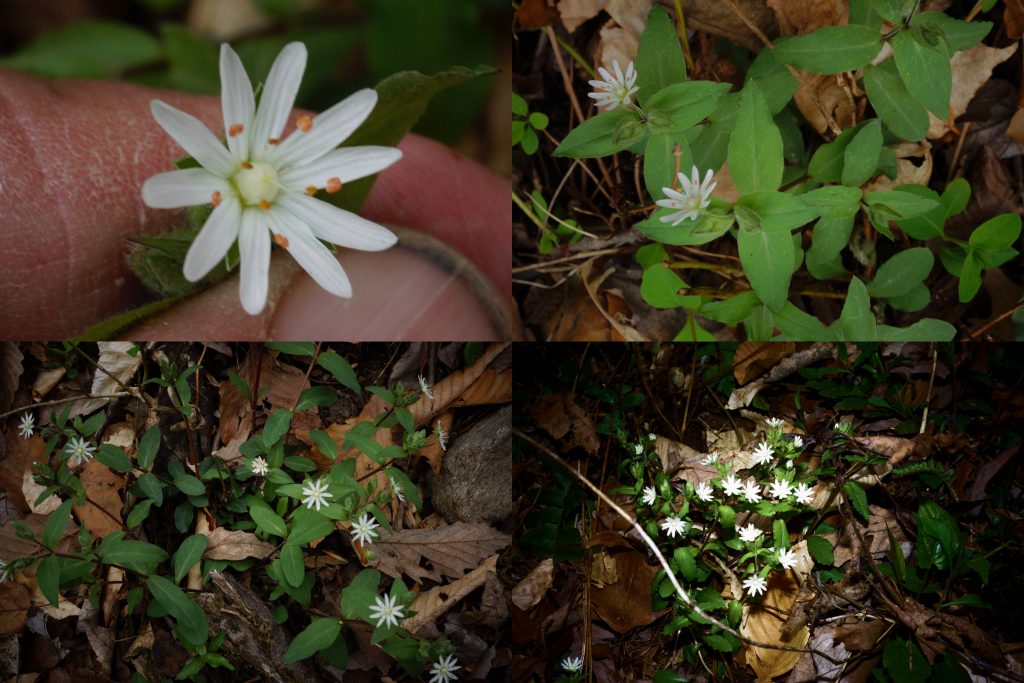
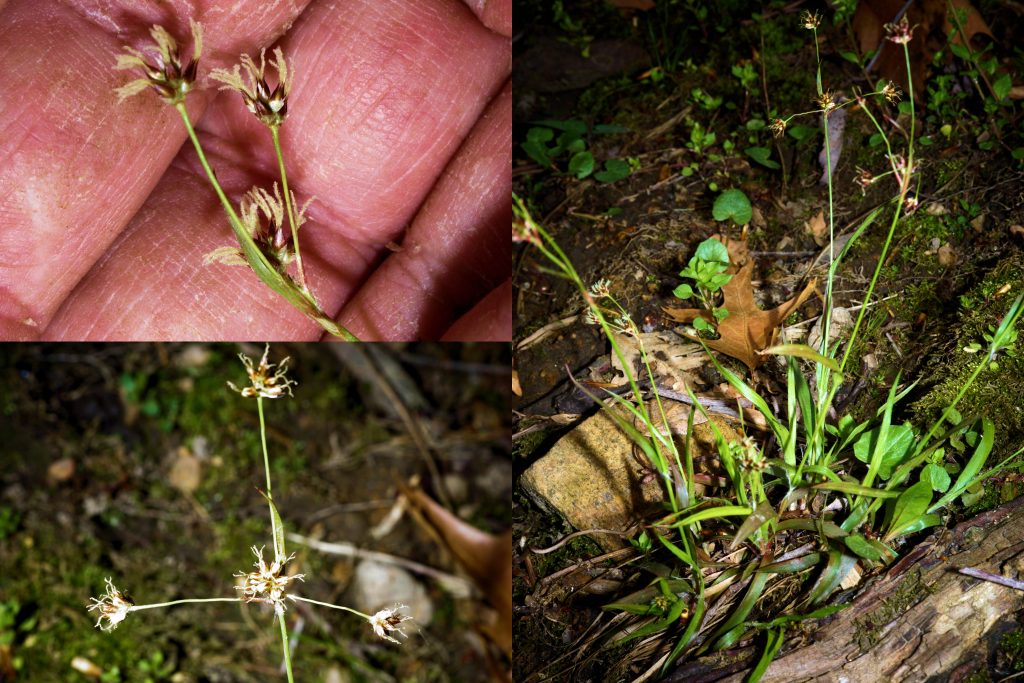
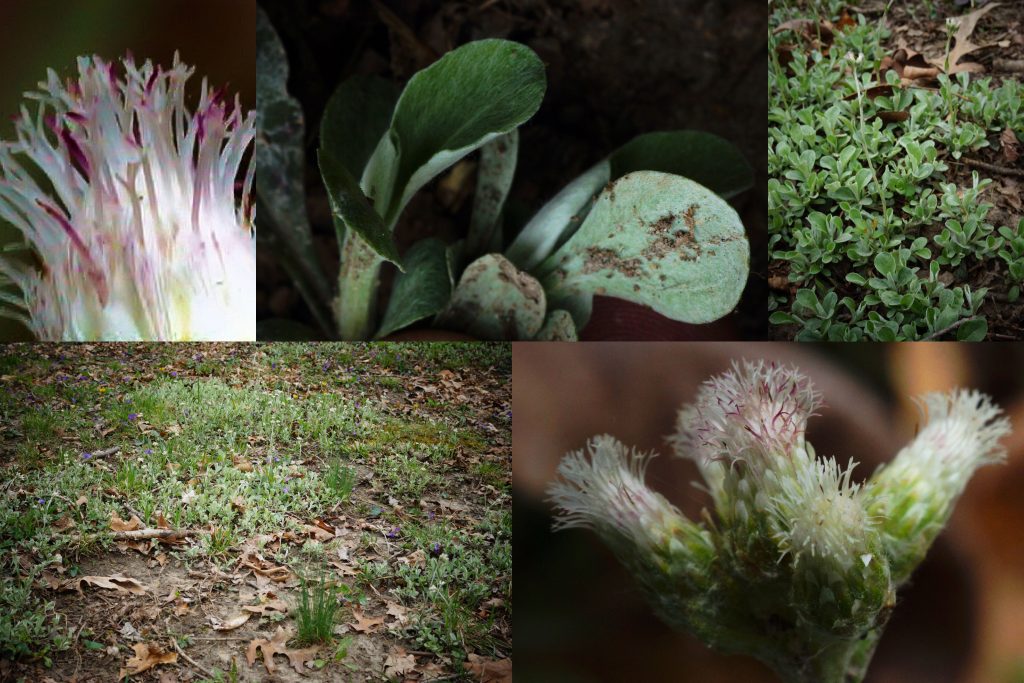

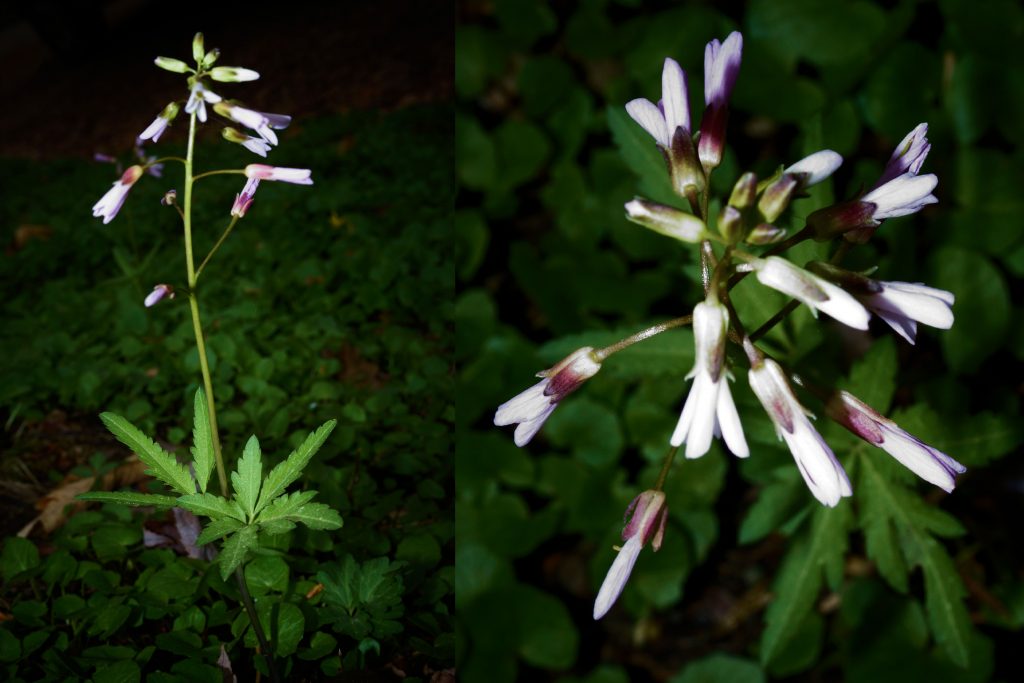

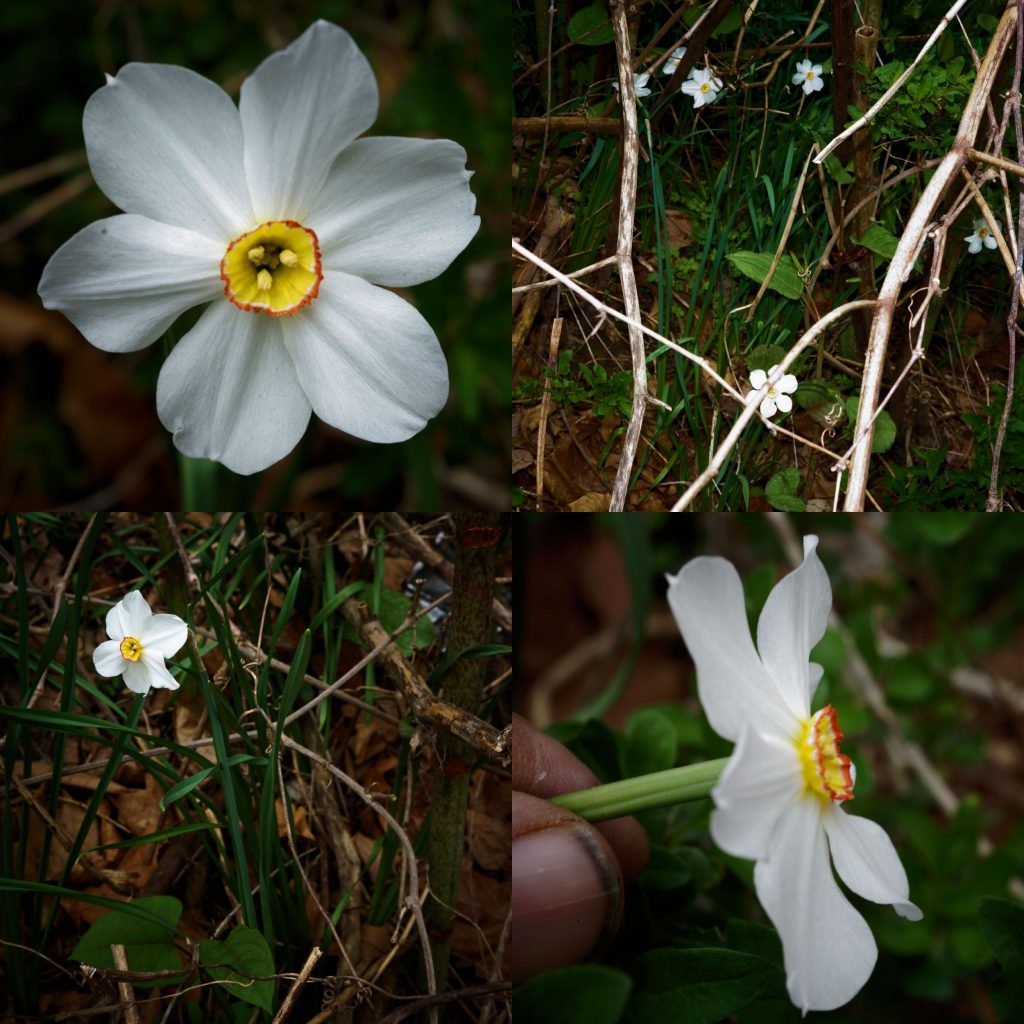
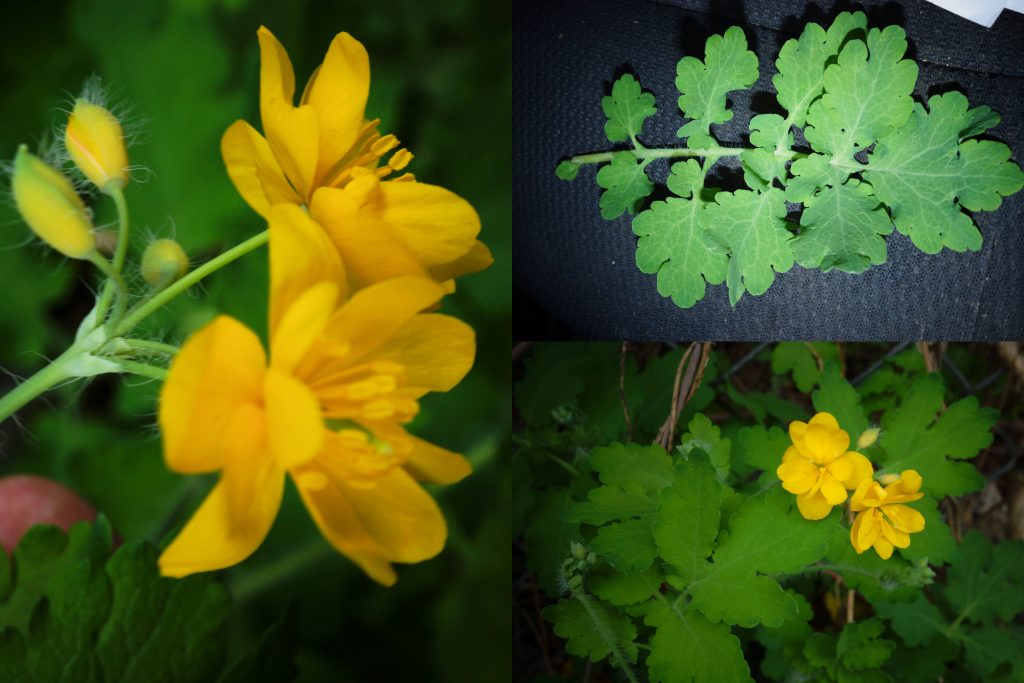

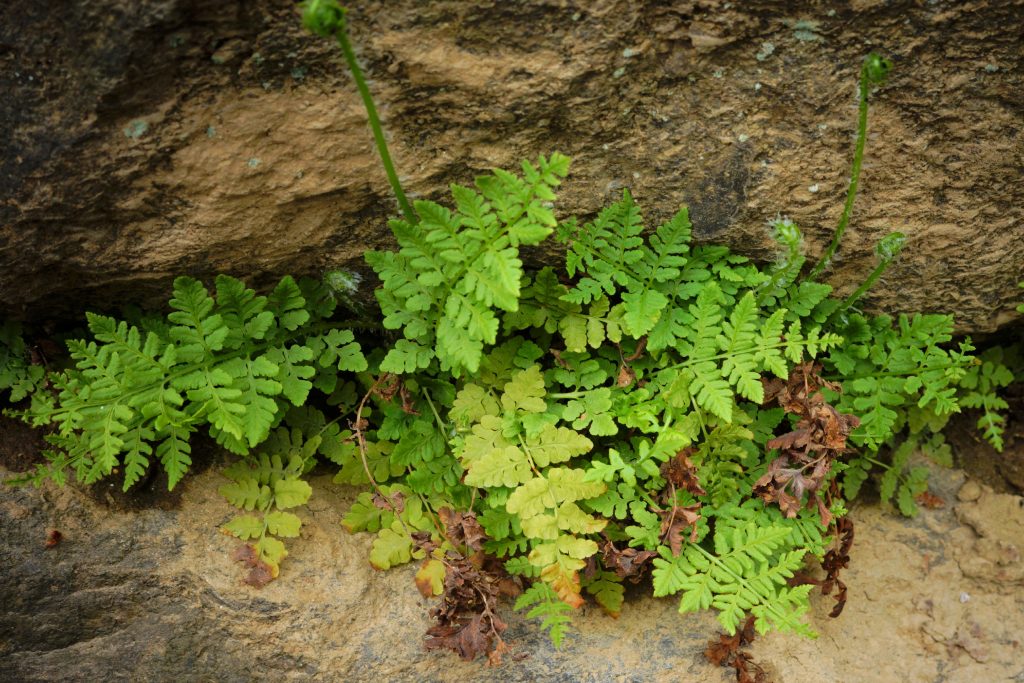
11 April 2017 – Cerastium
9 April 2017 – A Harbinger of Spring – Draba verna
 This tiny plant called Draba verna L. is a true harbinger of spring. It is always one of the first flowers to makes its presence known each year. In Maryland, it can usually be seen blooming as early as February, and even in January, if temperatures are warm enough like this year (2017).
This tiny plant called Draba verna L. is a true harbinger of spring. It is always one of the first flowers to makes its presence known each year. In Maryland, it can usually be seen blooming as early as February, and even in January, if temperatures are warm enough like this year (2017).
This member of the Brassicaceae family has several different “common” names. The one I usually hear it called is Whitlow Grass. The name- Erophila verna – is sometimes seen as a synonym in scientific literature.
It is native to Eurasia, and most literature I have seen says it has been introduced to North America. However, Wikipedia, without quoting a source, says it is now considered to be a native to North America. I have not found a source that validates this. If you know of such a source please let me know. At the very least, it is naturalized to North America.
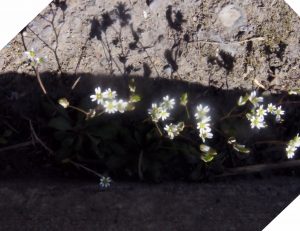 It is found on the refuge in disturbed areas like the edge of parking lots, roads, and other open areas where there is bare soil. It is a highly variable species generally growing from about 1 inch to 3 inches tall. I have seen it attaining heights of over 6 inches in favorable conditions.
It is found on the refuge in disturbed areas like the edge of parking lots, roads, and other open areas where there is bare soil. It is a highly variable species generally growing from about 1 inch to 3 inches tall. I have seen it attaining heights of over 6 inches in favorable conditions.
It is a hardy little guy that can truly be called a harbinger of spring.
8 April 2017 – Spring Wildflower Walk
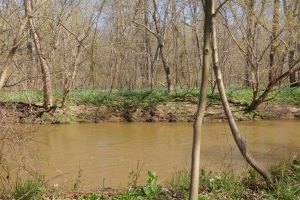
Today, the Little Patuxent River Trail located on the North Tract of the Patuxent Research Refuge was the scene for a spring wildflower walk sponsored by the Refuge.
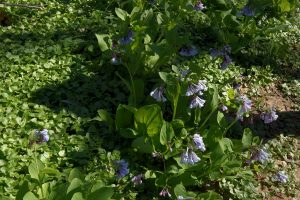
We identified a total of 32 species of plants and one species of lichen. (See list below). The bluebells put on an especially nice display. We did notice that the invasive Lesser Celandine took over more of the area compared to last year.
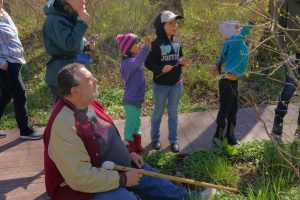
After the walk along the River Trail, we drove down to the Chickasaw Plum grove. In addition to the Chickasaw Plum we saw some Devil’s Tongue Cactus (Opuntia humifusa.)
A good time was had by all.
Flowers/Plants identified.
- Acer negundo L. – Boxelder
- Arabidopsis thaliana (L.) Heynh. – Mouseear Cress
- Cardamine hirsuta L. – Hairy Bittercress
- Carpinus caroliniana Walter – American Hornbeam
- Cerastium sp. – Mouse-ear Chickweed
- Cercis canadensis L. – Eastern Redbud
- Claytonia virginica L. – Virginia Spring Beauty
- Corydalis flavula (Raf.) DC. – Yellow Fumewort
- Dicentra cucullaria (L.) Bernh. – Dutchman’s Breeches
- Draba verna L. – Whitlow Grass
- Erythronium americanum Ker Gawl. – Dogtooth Violet
- Ficaria verna Huds. – Lesser Celandine
- Floerkea proserpinacoides Willd. – False Mermaidweed
- Glechoma hederacea L. – Ground Ivy
- Hydrophyllum virginianum L. – Eastern Waterleaf
- Lamium purpureum L. – Purple Deadnettle
- Lindera benzoin (L.) Blume – Northern Spicebush
- Mertensia virginica (L.) Pers. ex Link – Virginia Bluebells
- Micranthes virginiensis (Michaux) Small – Early Saxifrage
- Opuntia humifusa (Raf.) Raf. – Devil’s Tongue
- Packera aurea (L.) Á. Löve & D. Löve – Golden Ragweed
- Poa annua L. – Annual Blue Grass
- Polystichum acrostichoides (Michx.) Schott – Christmas Fern
- Prunus angustifolia Marshall – Chickasaw Plum
- Prunus cf. americana Marshall – American Plum
- Symplocarpus foetidus (L.) Salisb. ex W.P.C. Barton – Skunk Cabbage
- Taraxacum officinale F.H. Wigg. – Common Dandelion
- Veronica hederifolia L. – Ivyleaf Speedwell
- Veronica persica Poir. – Birdeye Speedwell
- Viola bicolor Pursh – American Field Pansy
- Viola eriocarpon (Nutt.) Schwein. – Downy Yellow Violet
- Viola sororia Willd. – Common Blue Violet
Lichen
Cladonia cristatella Tuck. – British Soldiers
8 April 2017 – American Field Pansy – Viola bicolor
 The American Field Pansy (Viola bicolor Pursh) is found throughout the eastern part of North America with a small number of outlying populations reported from the west. It is commonly found on the Refuge on all three tracts in open disturbed areas like the old firing ranges and powerline right-of-ways.
The American Field Pansy (Viola bicolor Pursh) is found throughout the eastern part of North America with a small number of outlying populations reported from the west. It is commonly found on the Refuge on all three tracts in open disturbed areas like the old firing ranges and powerline right-of-ways.
This species, with its dainty little flower, is distinguished from another annual Viola species found in Maryland (Viola arvensis Murray) by its petals which well surpassing its sepals. The flower’s five petals are usually white to a pale purple with darker stripes radiating from the flowers center, and are all the same color. The American Field Pansy is similar to Johnny Jump-ups (Viola tricolor.) The petals on that species are variously colored commonly with the lower three petals cream-white and upper two purple-black.
As is the case with other species, past controversy surrounds this one. The debate was over whether or not it was introduced from the Old World as a variety of Viola kitabeliana. Currently most botanists accept this as a separate species native to North America. A synonym for this plant is Viola rafinesquei Greene.
It is in full bloom in Maryland right now. See if you can find it.
REFERENCES
- Flora of North America Editorial Committee, eds. 1993+. Flora of North America North of Mexico. 20+ vols. New York and Oxford.
- “Viola bicolor“. NatureServe Explorer. NatureServe. Accessed 8 April 2017.
- Weakley, A.S. 2012. Flora of the Southern and Mid-Atlantic States. UNC Herbarium, North Carolina Botanical Garden. 1225 pp.
- Weakley, Ludwig, and Townsend. 2012. The Flora of Virginia.
7 April 2017 – Azure Bluets – Houstonia caerulea
Found a sizable patch of Azure Bluets (Houstonia caerulea L.) in full bloom on the Central Tract today, 7 April. It is differentiated from the similar looking Tiny Bluets (Houstonia pusilia) by its basally disposed leaves. Tiny bluets’s flowering stems are more branched and the leaves are less basally disposed. There are also some subtle differences in the measurements of the floral structures.
Azure Bluets are native in Eastern North America from Ontario and Newfoundland in the North, and from Louisiana and Florida in the south. There are scattered populations as far west as Oklahoma. They are fairly common in well-drained open fields and disturbed areas throughout the Refuge.
REFERENCE:
Weakley, A.S.2015. Flora of the Southern and Mid–Atlantic States. Working draft of 21 May 2015. Univ. of North Carolina Herbarium (NCU), Chapel Hill. <http://www.herbarium.unc.edu/flora.htm>
5 April 2017 – How to Identify Erythronium americanum

Today, I went to the refuge’s North Tract to look for some Yellow Dogtooth Violets or Trout Lilies (Erythronium) to take some pictures of the inner floral parts for identification purposes. According to the available literature, Erythronium americanum has two “ears” (or auricles) at the base of the petals (inner three tepals) and the ovary is dimple-less. The detail on these photos fit that description. For the record, although I did not take a photo of the anthers, they contained yellow pollen.
Another yellow Erythronium that is reportedly found (unverified) in Maryland (Erythronium umbilicatum) does not have “ears” (or auricles) at the base of the petals and the ovary/seed capsule has a dimple at the apex. Who will be the first one to find this species in Maryland?
UPDATE
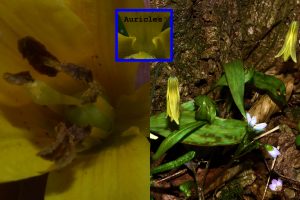
As of 7 April, I have examined over 30 Erythonium plants on the Refuge’s North Tract and Central Tract. They all had auricles, meaning they are all Erythronium americanum.
References:
- Flora of North America Editorial Committee, eds. 1993+. Flora of North America North of Mexico. 20+ vols. New York and Oxford.
- Weakley, A.S. 2012. Flora of the Southern and Mid-Atlantic States. UNC Herbarium, North Carolina Botanical Garden. 1225 pp.
- Weakley, Ludwig, and Townsend. 2012. The Flora of Virginia.
4 April 2017 – Tiny Pants on Tiny Plants
Dutchman’s Breeches – Dicentra cucullaria (L.) Bernh. is favorite of those who are familiar with spring ephemeral wildflowers because if one uses their imagination, little man in pants hanging upside down can be envisioned when looking at the flowers. No wonder the forest is the setting for many a fairy tale.
Dutchman’s Breeches are found in Eastern North America and believe it or not, in isolated naturally occurring populations in Washington, Oregon and Idaho. They grow best in bottomland forests and adjacent areas. On the Refuge, they are common along both the Patuxent River and the Little Patuxent River.

The plant is similar to Squirrel Corn – Dicentra canadensis (L.) Bernh. The flower spurs on Dutchman’s Breeches are more pointed that the ones on Squirrel Corn. The leaves on Squirrel Corn are generally more finely dissected. In both species, the “down” end of the flowers contain the reproductive parts.
Native Americans used the plant for medicinal purposes.
REFERENCES:
- “Dicentra cucullaria”. Flora of North America (FNA). Missouri Botanical Garden – via eFloras.org. Accessed 8 April 2017
- “Dicentra cucullaria”. NatureServe Explorer. NatureServe. Accessed 8 April 2017.
- Weakley, A.S.2015. Flora of the Southern and Mid–Atlantic States. Working draft of 21 May 2015. Univ. of North Carolina Herbarium (NCU), Chapel Hill. <http://www.herbarium.unc.edu/flora.htm>
4 April 2017 – Yellow Fumewort
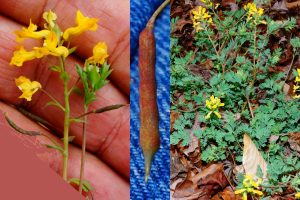 Yellow Fumewort – Corydalis flavula (Raf.) DC. – is another spring bloomer that is a denizen of bottomland woods and adjacent areas and is commonly found in parts of Eastern North America. As typical of a member of the Papaveraceae family (poppy) it contains a large number of alkaloids. It ranges from Ontario in the north, the Eastern Seaboard on the east, the Gulf Coast on the south, and Nebraska and Kansas on the West. It is conspicuously absent from New England except for a small number of populations in Connecticut.
Yellow Fumewort – Corydalis flavula (Raf.) DC. – is another spring bloomer that is a denizen of bottomland woods and adjacent areas and is commonly found in parts of Eastern North America. As typical of a member of the Papaveraceae family (poppy) it contains a large number of alkaloids. It ranges from Ontario in the north, the Eastern Seaboard on the east, the Gulf Coast on the south, and Nebraska and Kansas on the West. It is conspicuously absent from New England except for a small number of populations in Connecticut.
Yellow fumewort’s flowers are bilaterally oriented and its leaves are finely dissected. The seed pod is pendant and contains several seeds.
It is found in the Refuge’s bottomland woods.
3 April 2017 – Chickasaw Plum – How to Identify
1 April 2017 – Chickasaw Plum
Today at the Patuxent Research Refuge, we stopped by the Chickasaw Plum “Grove” (Prunus angustifolia Marshall). There are two clumps of the trees at this location, and they put on a nice display.
According to Sargent in 1965 and E.L. Little in 1979, this species was originally native to central Texas and Oklahoma, and was naturalized beyond that range (including Maryland) by Native Americans in pre-European settlement times. Renown botanist William Bartram wrote that “he never saw the Chickasaw plum wild in the forests but always in old deserted Indian plantations”. He hypothesized that the Chickasaw Indians brought it from the Southwest beyond the Mississippi River (Bartram, 1791).
So we may surmise that these trees could have likely been planted by Native Americans many centuries ago.
- Bartram, W. 1791. Travels through North and SouthCarolina, Georgia, East and West Florida. In Little, E. L. Checklist of United States Trees. USDA FS Washington, D.C.
- Little, E. L. 1979. Checklist of United States Trees. USDA FS Washington, D.C.
- Sargent, C. S. 1965. Manual of the trees of North America. 2nd Ed. Vol. II. Dover Pub., Inc. New York. 934p.
30 December 2016 – Hairy Bracken Fern
https://www.flickr.com/photos/11582493@N02/31204967503/
This bracken fern is another species of fern that we found on our nature walk. This variety is called the Hairy Bracken Fern or Pteridium aquilinum (L.) Kuhn var. pubescens Underw. It differs from the Bracken Fern commonly found on the Patuxent Research Refuge with shorted terminal segments on the well-developed pinnules, The Hairy Bracken Fern is found in Western North America from Alaska to Northern Mexico, as far east as Texas and South Dakota.
It forms colonies which can be invasive, especially in hay fields.
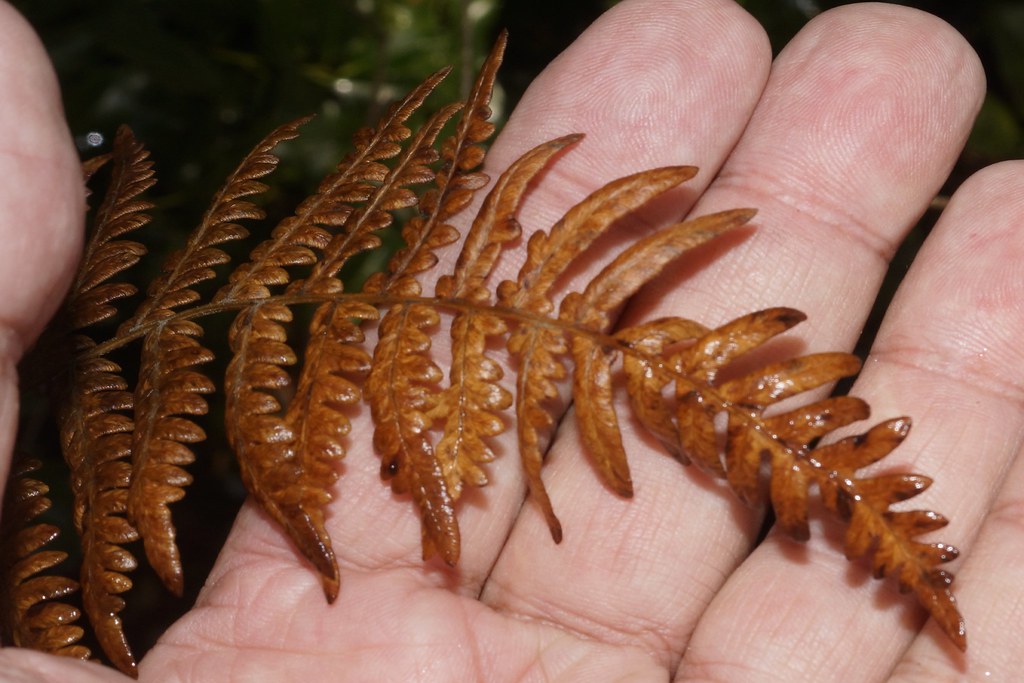
30 December 2016 – Western Sword Fern
https://www.flickr.com/photos/11582493@N02/31153362664/
Western Swordfern growing in Bellevue, Washington 30 December 2016.
The Western Sword Fern (Polystichum munitum (Kaulf.) C. Presl) is an evergreen fern found on the west coast of North America from Southeastern Alaska to Southern California. There are isolated populations in the Black Hills in South Dakota and on Guadalupe Island off Baja California.
Its favorite habitat is in the understory in conifer forests. Native Americans peeled and roasted the rhizomes for food.
It is difficult to grow and cultivate in the eastern past of North America.
30 December 2016 – Nature Hike with Granddaughters in Bellevue

Today,my granddaughters in Seattle and I took a hike on the Boeing Trails in Bellevue Washington. We saw several types of native trees as well as the non-native American Holly. We also saw the Western Sword Fern and the ubiquitous blackberry patches, which are common in the urban areas in Western Washington.
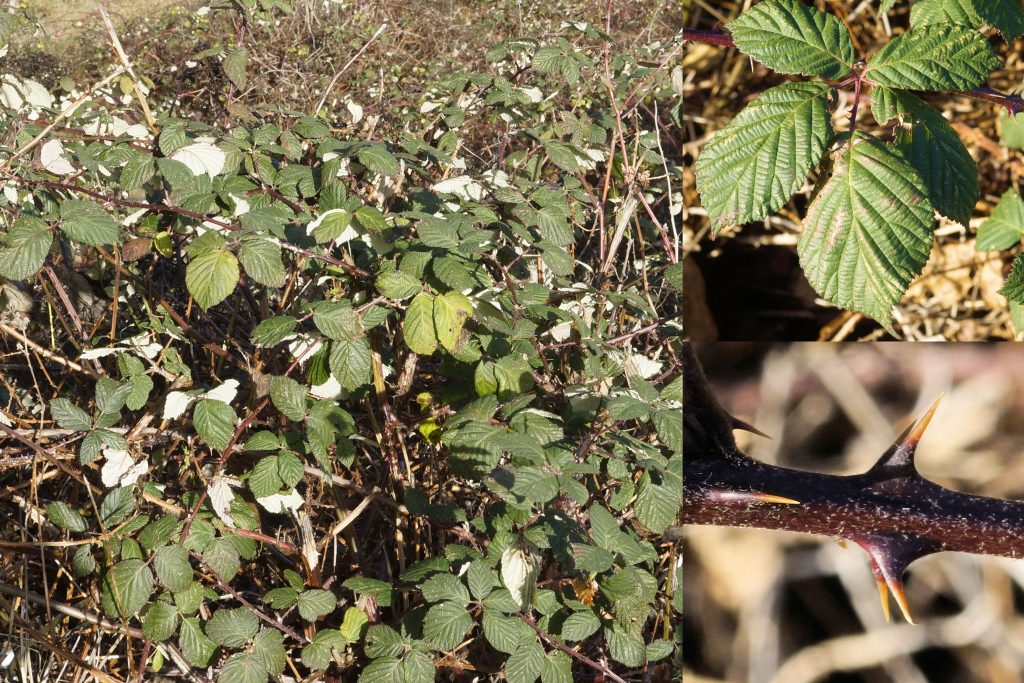
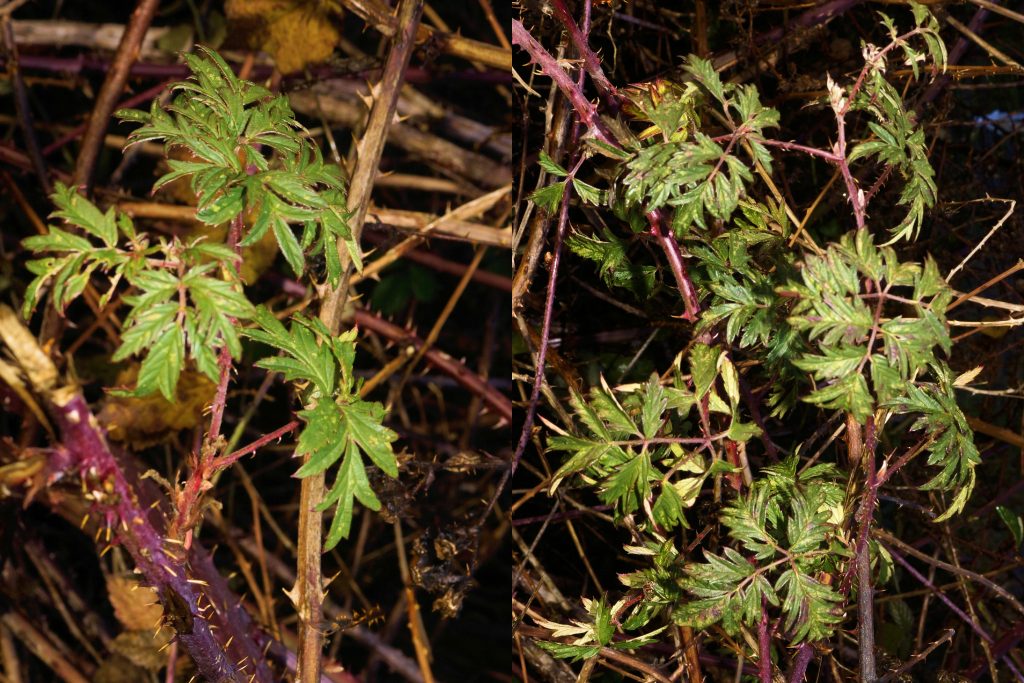
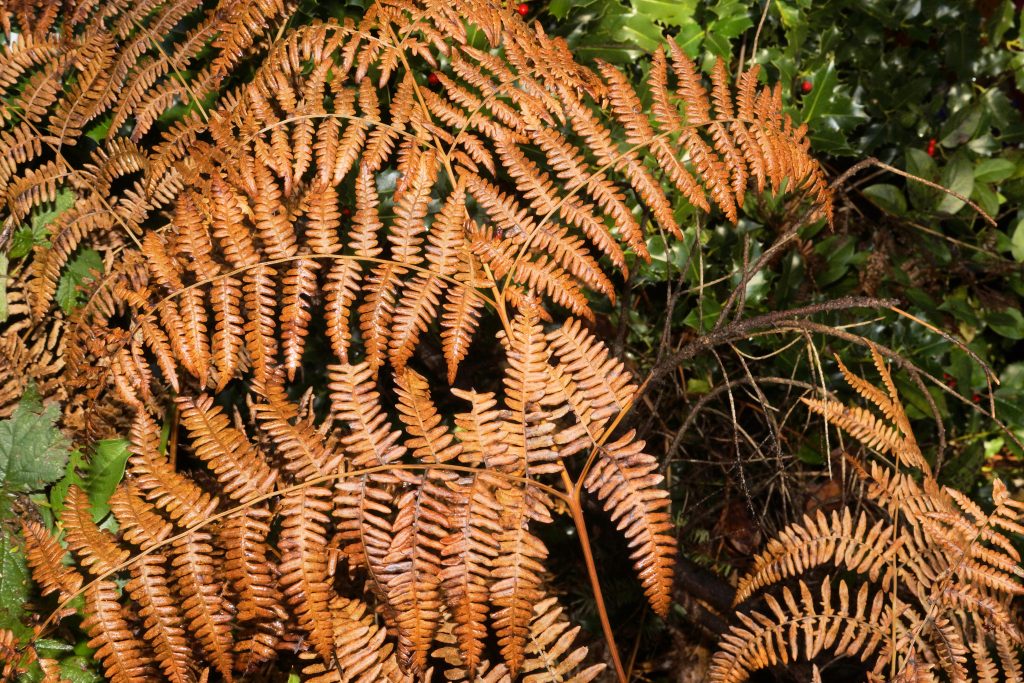

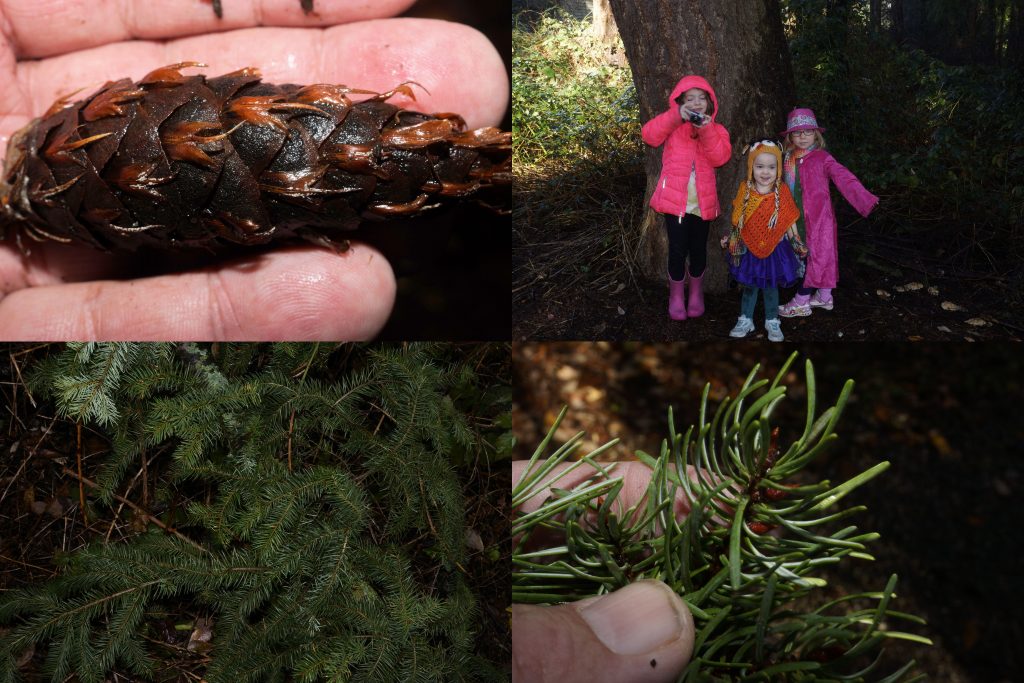
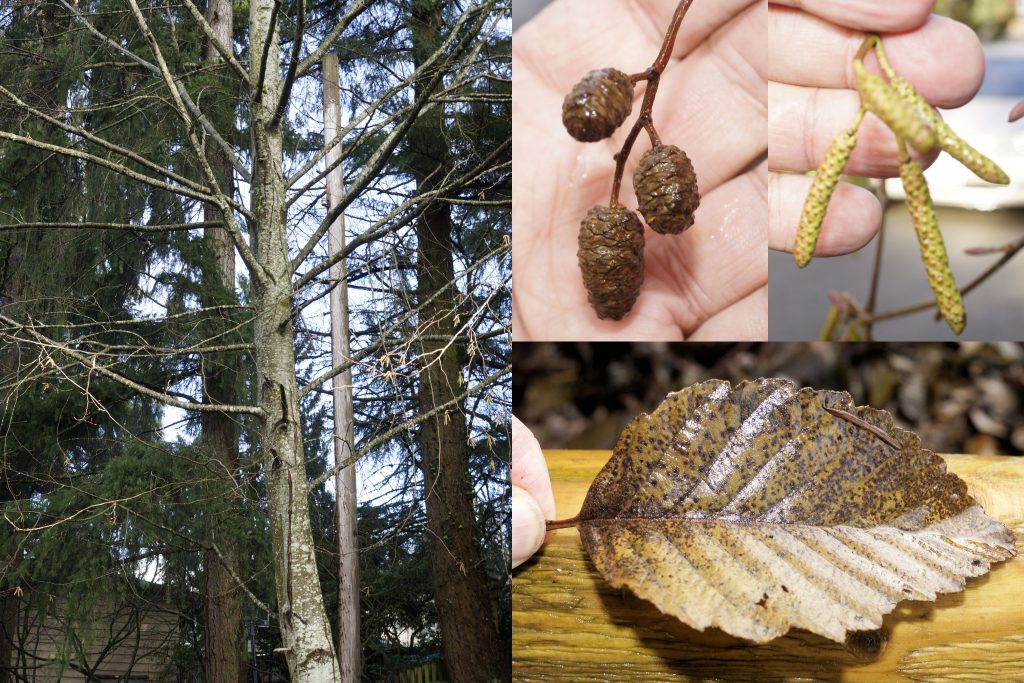
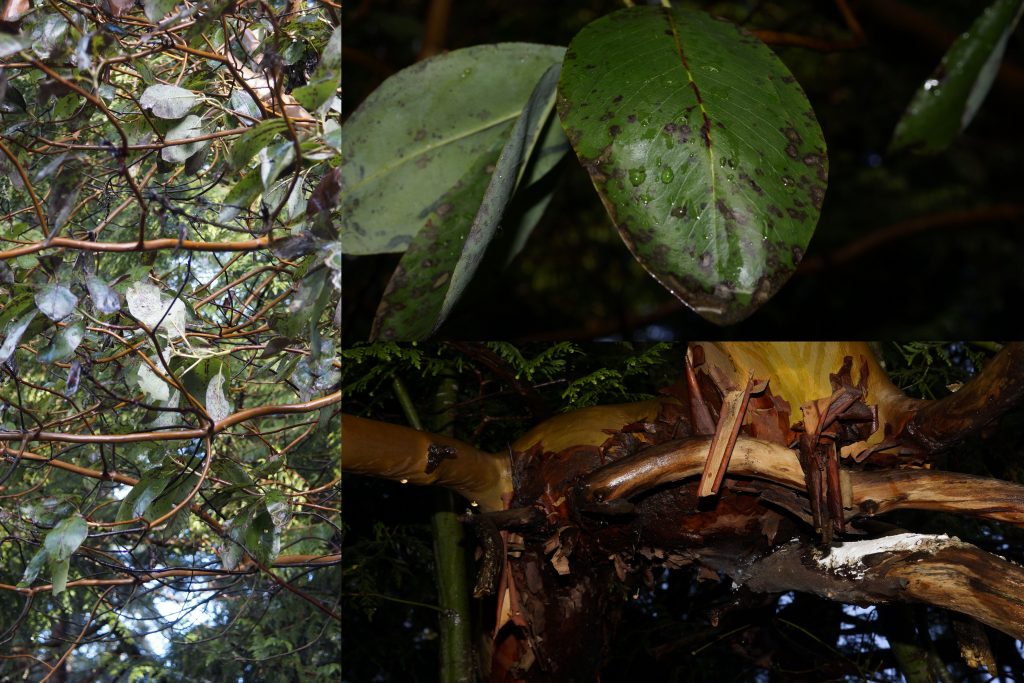

5 September 2016 – Hyssop-leaf Thoroughwort and Torrey’s Thoroughwort
This time we will examine two similar species of Thoroughwort (sometimes called boneset) – Hyssop-leaf Thoroughwort (Eupatorium hyssopifolium L.) and Torrey’s Thoroughwort (Eupatorium torreyanum Short & Peter). The synonym Eupatorium hyssopifolium L. var. laciniatum A. Gray is sometimes applied to Torrey’s Thoroughwort.
The difference between the two species is subtle, but distinct and is mainly seen on the leaves.

The shape of principal leaves on the Eupatorium hyssopifolium are described as linear to narrowly lanceolate. Additionally, they are generally shorter (2 to 7 cm long) and narrower (1-5 mm wide) than the Eupatorium torreyanum, and are 10 to 40 times longer than wide. Also, the margins of their leaves are mostly entire or obscurely toothed.

On the other hand, the principal leaves on the Eupatorium torreyanum are described as lanceolate, 5 to 12 cm long and 5 to about 10 mm wide. The length to width ratio is 6 to 15. The margins of the leaves are conspicuously and divergently toothed.

Hyssop-leaf Thoroughwort naturally occurs in Eastern USA from Massachusetts on the north, Georgia on the south and Tennessee on the west. It is common throughout Maryland and on the Refuge.

Botanists have found Torrey’s Thoroughwort from New York on the north, to Florida on the south, and to Ohio, Tennessee, and Louisiana on the West. It is considered to be a viable hybrid between Hyssop-leaf Thoroughwort and another species of Eupatorium. The identity of the other parent species is a matter of controversy and requires further research.
Interestingly, Torrey’s Thoroughwort is listed as occurring in Maryland, yet the Maryland Biodiversity Project (MBP) and the Maryland Plant Atlas (MPA) have no report (as of 5 September 2016). Maybe this is the first known report of this species, or previous reports of it just have not been documented yet. In any event, this species is often overlooked because of its co-occurrence with Hyssop-leaf Thoroughwort, and observations of it could be easily dismissed because it is so similar in appearance.
Some botanists elevate Torrey’s Thoroughwort to a species level, others subordinate it as a variety of Hyssop-leaf Thoroughwort, and others have lumped these two together into one species. Whatever its taxonomical status, Torrey’s Thoroughwort is definitely a distinct botanical entity from Hyssop-leaf Thoroughwort.
REFERENCES:

Maryland Biodiversity Project – http://www.marylandbiodiversity.com
Maryland Plant Atlas – http://www.marylandplantatlas.org
Sullivan, J.R. 1978. Putative hybridization in the genus Eupatorium (Compositae). Rhodora 80: 513-527.
